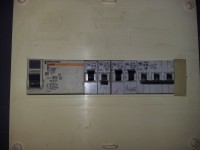Hello
I am in the process of renovating the kitchen and my distribution of receivers will change a bit. I have a few questions about this:
1. 3-phase cable - normally the oven 230, induction 230 + dishwasher was connected to it.
Now it's supposed to be induction + Dishwasher.
Induction - maybe I would finally connect it to 2 phases. Dishwasher - standard -230
I've seen mini switching stations in building warehouses - for a 3-phase socket + 1-phase socket. Or maybe there are switchboards for a 2-phase socket (for induction) + 1-phase socket - for a dishwasher. Is such a separation of phases on a common neutral and grounding a correct action?? Are additional protections applied in such switchgears? I mean something like this:
https://www.obi.pl/plugs-and-gniazda/socket-typu-kombi-tk-cee-5-biegunowe16-a/p/6028393
The second thing is to connect the oven. In the place where it is supposed to be, there is a socket 230.
But here the fridge + microwave + this unfortunate oven is to be connected. It is known that the oven will not work together with the microwave - maybe with a few exceptions - but does such a connection make sense.
Will I have to pull another 230V section unfortunately?
Or is there any other solution?
I am in the process of renovating the kitchen and my distribution of receivers will change a bit. I have a few questions about this:
1. 3-phase cable - normally the oven 230, induction 230 + dishwasher was connected to it.
Now it's supposed to be induction + Dishwasher.
Induction - maybe I would finally connect it to 2 phases. Dishwasher - standard -230
I've seen mini switching stations in building warehouses - for a 3-phase socket + 1-phase socket. Or maybe there are switchboards for a 2-phase socket (for induction) + 1-phase socket - for a dishwasher. Is such a separation of phases on a common neutral and grounding a correct action?? Are additional protections applied in such switchgears? I mean something like this:
https://www.obi.pl/plugs-and-gniazda/socket-typu-kombi-tk-cee-5-biegunowe16-a/p/6028393
The second thing is to connect the oven. In the place where it is supposed to be, there is a socket 230.
But here the fridge + microwave + this unfortunate oven is to be connected. It is known that the oven will not work together with the microwave - maybe with a few exceptions - but does such a connection make sense.
Will I have to pull another 230V section unfortunately?
Or is there any other solution?



